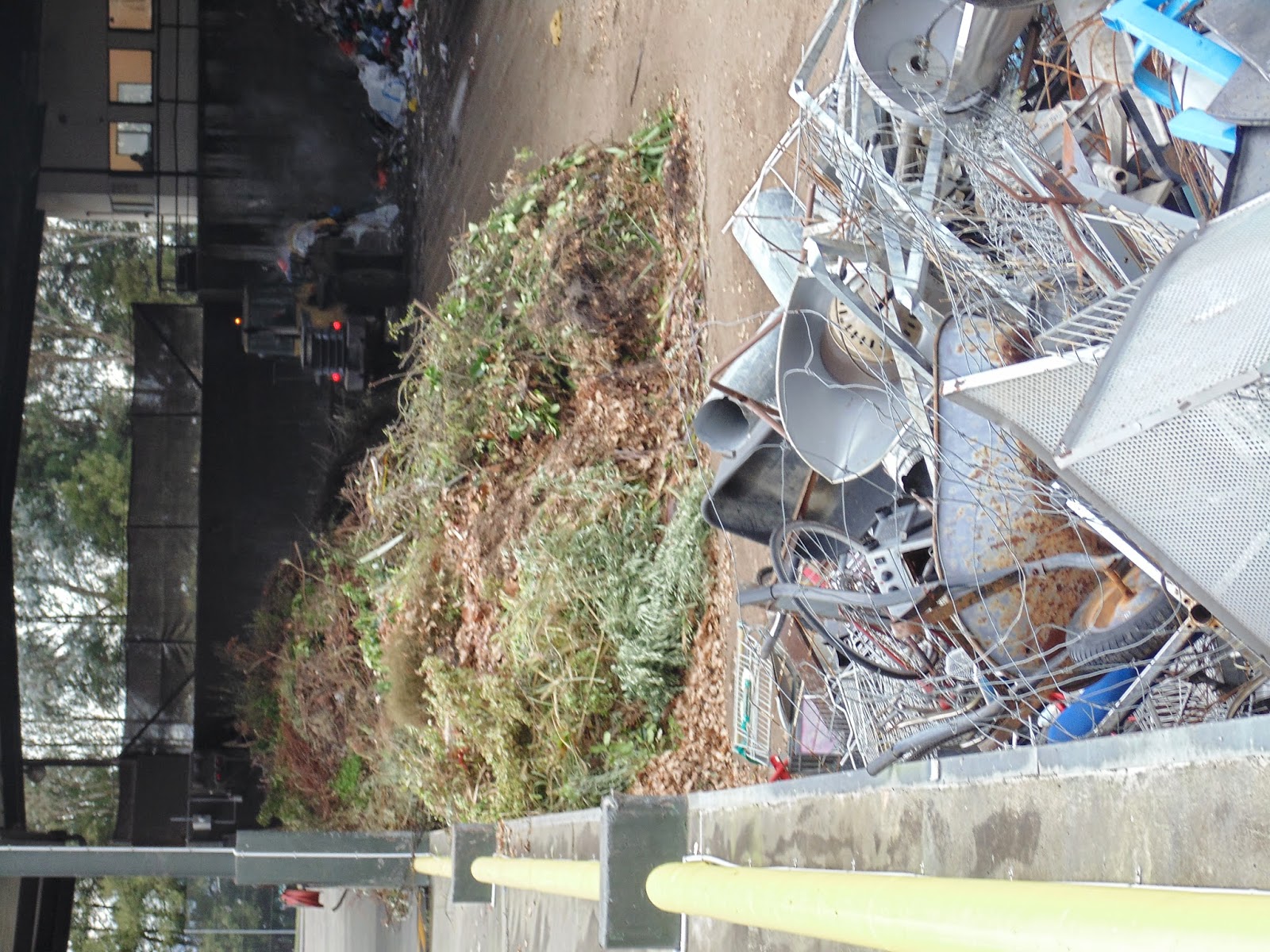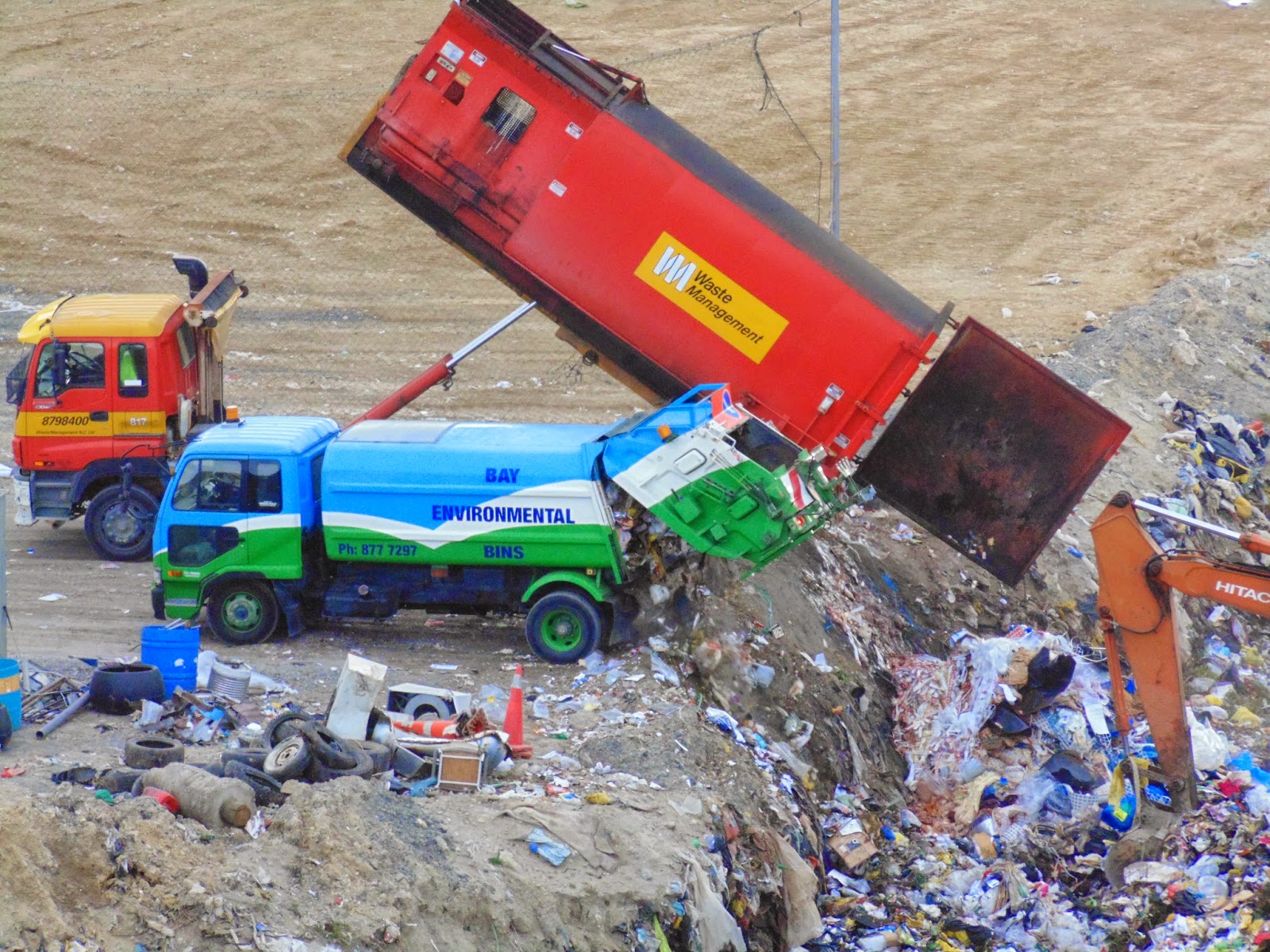To conclude our Environment Inquiry we went to the Refuse Transfer Station on Henderson Road in Flaxmere and then on to the Landfill.
A refuse transfer station (RTS) is a place where the public, including businesses and industries, can get rid of their waste. It is a station where rubbish is stored and sorted before to its transferred to the rural landfill.
Dominic was our teacher for the morning. He knows everything about the Refuse Centre and the Landfill!
Dominic started by showing us all the different sorts of plastics there are. Most plastic containers can be recycled. They are graded 1 -7 and marked with the recycling triangle symbol. If the number is higher than 7 it can't be recycled, like the new Anchor milk bottle that you can't see through. If there is no number it can't be recycled either. Meat trays cannot be recycled because they are contaminated with animal blood. Did you know you can recycle your yoghurt containers? Did you also know that normal plastic milk bottles are recycled and made into polar fleece?!
We found out that if you live in the country and don't have your rubbish collected by a council rubbish truck you can get these orange bags from the council, fill them with your rubbish and drop them at the Refuse Station for free. They are then taken to the landfill.
The big sign on this bin tells people all the things Dominic was telling us about at the beginning - you can put in milk bottles, drink bottles, tin cans, aluminium cans and any containers with the recycle sign 1 -7.
This is a waste oil container. They use it to make more plastic.
The different coloured bottles are kept separate because they don't change colour when they are recycled.
Did you know that glass is made out of sand and that when they recycle it its just about turned back into sand before been made into another glass thing?!
These three pictures show things that have been separated from the rubbish so they can be reused. They have set up a shop with things people don't want to keep any more but they think are too precious to throw out. Dominic said, "one person's rubbish is another person's treasure." The old bikes are sent to the prison where the prisoners fix them up and then they are sold to be used again.
When a truck or vehicle comes into the station it is weighed, it dumps the rubbish and then it is weighed again as it leaves and the driver has to pay for the difference in weight at this little office. We all stood on the monster scales. 29 students and 10 adults weighed 2015 kg! It would cost about $400 to get rid of us!!!
This lop-sided photo shows how they keep the different types of waste separate. Green waste is recycled into compost and people use compost in their gardens. Metals are sorted and some are melted down and made into other things, e.g. exhaust pipes.
These leaves are being tipped into the green waste area - more compost!
Metals that can't be recycled go to the Landfill.
Here we are standing just above the pit where rubbish is being sorted.
This loader was pushing the rubbish that can't be recycled or reused into a big hole at the end of the pit. The hole is exactly the same size as the massive rubbish truck that drives in underneath the pit to fill up with rubbish. It is then taken to the Landfill.
This corner is where the loader pushes the rubbish that will end up in the landfill. It was so smelly and we could actually see greenhouse gases oozing out of the rotting pile. It looked like steam.
Having the hole in the pit above makes it easy for the truck to be loaded. Once the truck has all of the rubbish from the pit above in it, it drives straight to the landfill.
Dominic told us that we were going to landfill after we had had morning tea and that we would probably see that very truck dumping its load when we get there.
Back in the bus on the road to the Landfill.
It was quite spooky driving into the landfill. The rough stones in the ditches on the side of the road help stop rubbish blowing away. You can see the office building in front of us. When the bus stopped Dominic was already there and he gave Mrs Anderson a big plastic container full of fluorescent green vis vests which we all had to put on. The adults had to wear fluorescent orange ones. This was so everyone could be seen at all times.
Dominic was telling us that where we were standing was a man-made hill of about 30 years of rubbish! The landfill is a humongous area and it is completely surrounded by very high wire fences. These are to catch any loose rubbish flying around. When it gets very, very windy they put up temporary fences made out of recycled fishing nets and put them in certain places depending on which way the wind is blowing. Another funny thing we found out from Dominic was that all around the fences, about 10 metres apart, are air fresheners! They are attached to the top of the high fences and every so often they squirt a burst of water mixed with eucalyptus to freshen the air and to keep the neighbours happy!!!
Below where we were standing was the new pit. Dominic said a landfill is like a rubbish pie - the crust is the bottom of the 'crater' which is like the crust of the pie made up of pipes, clay and lime. The filling of the pie is all of the rubbish. Trucks unload rubbish into the pit while a digger spreads it around evenly. Every evening the machines work to cover all of the filling (rubbish) with dirt so it all stays in place. Every morning the dirt is removed and off they go again, filling the pit with rubbish - about 62 trucks a week in Summer and about 25 trucks a week in Winter.
The big orange truck does the city street collections in Napier and Hastings and holds 20 tonnes of rubbish and the smaller blue truck collects rubbish from local businesses and holds 4 tonnes of rubbish. After a truck has dumped a load the driver has to sweep down the whole truck before leaving the landfill.
This huge Cat 826H bulldozer works in the pit all day making the rubbish take up less space. It roars up onto the rubbish with its heavy, spiky wheels grinding its way through and leaving a squashed, flattened dark trail behind it.
Rubbish and more rubbish!
This is where we standing while we were watching the work been done in the pit below.
This truck is off to refill and do it all over again. The funny looking thing sitting on the edge of all the rubbish is connected to the pipes in the 'crust' of the 'rubbish pie' and it processes the greenhouse gases and releases cleaner gases into the air. There are lots of them around the edges of the pit.
Here they are building a power station that will power 1,000 houses oneday. The gases that come from the landfill will be turned into power!
Here we are at the end of our fascinating trip. Dominic told us he was very impressed with all of the questions we asked and how much we knew about our environment. He said he's had high school kids come to visit that didn't know and ask about stuff as much as we did. Guess what's underneath this sweet looking, grassy hill we are sitting on??!!
































Wow Room 6! It looks like this was a worthwhile trip! I think it's very interesting that Hawke's Bay produces so much more rubbish in the summertime! Your comments and photos are all very interesting - great effort!
ReplyDelete